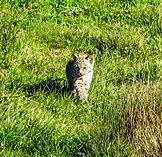Wild
Mount Diablo
Wild Mount Diablo provides a series of short videos highlighting a rare, threatened, or unique native plant or animal. Each clip focuses on the natural history, ecological role, or conservation status, and helps you appreciate why it matters—or why it's cool.
Presented by Mount Diablo Interpretive Association. Produced by Joan Hamilton, Wally De Young, Kendall Paul Oei, and Staci Hobbet.

Joan Hamilton

Wally De Young

Kendall Paul Oei

Staci Hobbet
Scarlet Pumpernickel?
How a tiny flower rose to stardom, inspiring numerous works of "first-class escapism."
A Mount Diablo Interpretive Association video in the "Wild Mount Diablo" series. Featuring Ken Lavin. Photos by Scott Hein, Neal Kramer, and Andrew Waugh, clu, seven75, tamayalper (iStock). Music by Christian Andersen. Production by Joan Hamilton. Thanks to Wild Mount Diablo team members Wally De Young, Staci Hobbet, Kendall Oei.
Plant People
Mount Diablo is a treasure trove of rare plants. Learn about the unusual species you can find there—and about the botanists who've made a name for themselves on its slopes.
A Mount Diablo Interpretive Association video produced in partnership with Save Mount Diablo by Joan Hamilton. Featuring botanist Heath Bartosh. Images by Heath Bartosh, Dan Fitzgerald, Scott Hein, Kendall Oei. Music by Daniel Kaede and Headlund/Epidemic Sound.
Wild Babies
Meet the Wild Babies of Mount Diablo, and learn what superpowers each is developing as they grow from babes in the woods, to full grown predators - or prey! Whether sharp toothed and venomous, or soft and fluffy, these wild babies are sure to surprise you with their innate gifts.
Are baby rattlesnakes really more dangerous than adults? Are a Great Horned Owls’ eyes really as large as a humans’? Which mom carries over 100 babies on her back?
Watch Wild Babies, and be prepared to be surprised!
Pines
Can you name three pine species that grow in Mount Diablo State Park? Learn to ID them by their pinecones (2 supersized, 1 clingy). Hear about how they're adapted to fire and drought. Meet the gun-toting botanists who collected their cones in the 1830s.
A Mount Diablo Interpretive Association video featuring Ken Lavin and Seth Adams. Production by Joan Hamilton. Music by Music Revolution. Photos by Joan Hamilton, Neal Kramer, Kendall Oei, and courtesy of Strybing Arboretum. Adapted from Audible Mount Diablo's Curry Point, Mitchell Canyon, and Falls Trail guides sponsored by Mount Diablo Interpretive Association and Save Mount Diablo. Special thanks to Wild Mount Diablo team members Wally De Young, Anastasia Hobbet, and Kendall Oei.
Peregrine Falcons 2022
Join Wild Mount Diablo as we hear the story of how a local apex predator, the peregrine falcon, fared in 2022, following the difficult 2021 season, when all four chicks, banded and almost ready to fly, were killed by a great-horned owl in a territorial dispute. Follow MDIA’s Peregrine Team of naturalists, stewards, and detectives as they tell the story of how the fastest animal on the planet fared this last season. We plan an annual update on these beautiful birds of prey. The 2023 season, now underway, is developing into another wholly different story.
A Mount Diablo Interpretive Association video, produced by Wally De Young.
Ladybugs
Mount Diablo hosts large congregations of ladybugs in winter. Perhaps you've seen them? Masses of writhing, reddish-orange beetles in a shady canyon? It can be an arresting, even creepy, sight. Which is all part of their clever survival plan.
A Mount Diablo Interpretive Association video featuring naturalist Ken Lavin. Images by Arnold Joe, Scott Hein, and Kendall Oei. Music by Daniel Kaede. Produced by Joan Hamilton. Adapted from "Mitchell Canyon" Audible Mount Diablo, 2017.
Oak Mistletoe
Ah . . . fall on Mount Diablo! Golden grasses, auburn chamise, and bare deciduous oaks. But wait! Some of the oaks' branches are festooned with a green, beach-ball-size plant. The Druids considered it the soul of the tree. But the real story is more complicated!
A Mount Diablo Interpretive Association video featuring naturalist Ken Lavin. Produced by Joan Hamilton. Videography and photos by Kendall Oei, with Wally De Young, Staci Hobbet, and Neal Kramer. Music by Miguel Angel Albentosa Bo. Adapted from "Plants of Twin Peaks," Audible Mount Diablo, 2013.
River Otters of the Mount Diablo Watershed
River otters on Mount Diablo?
No, but join Wild Mount Diablo and explore how the mountain's many headwaters feed the creeks and canals of the watersheds below, providing river otters and other water-loving creatures with essential habitat.



















